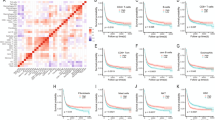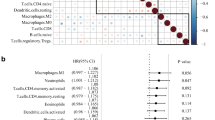Abstract
Acute myeloid leukemia (AML) is a lethal hematologic malignancy with a variable prognosis that is highly dependent on the bone marrow microenvironment. Consequently, a better understanding of the AML microenvironment is crucial for early diagnosis, risk stratification, and personalized therapy. In recent years, the role of bioinformatics as a powerful tool in clarifying the complexities of cancer has become more prominent. Gene expression profile and clinical data of 173 AML patients were downloaded from the TCGA database, and the xCell algorithm was applied to calculate the microenvironment score (MS). Then, the correlation of MS with FAB classification, and CALGB cytogenetic risk category was investigated. Differentially expressed genes (DEGs) were identified, and the correlation analysis of DEGs with patient survival was done using univariate cox. The prognostic value of candidate prognostic DEGs was confirmed based on the GEO database. In the last step, real-time PCR was used to compare the expression of the top three prognostic genes between patients and the control group. During TCGA data analysis, 716 DEGs were identified, and survival analysis results showed that 152 DEGs had survival-related changes. In addition, the prognostic value of 31 candidate prognostic genes was confirmed by GEO data analysis. Finally, the expression analysis of FLVCR2, SMO, and CREB5 genes, the most related genes to patients’ survival, was significantly different between patients and control groups. In summary, we identified key microenvironment-related genes that influence the survival of AML patients and may serve as prognostic and therapeutic targets.





Similar content being viewed by others
Data Availability
The data that support the findings of this study are available from GEO database (https://www.ncbi.nlm.nih.gov/geo/) and TCGA database (https://portal.gdc.cancer.gov/), which are all publicly available.
References
Mizani, S., Keshavarz, A., Vazifeh Shiran, N., Bashash, D., & Allahbakhshian, F. M. (2022). Expression changes of SIRT1 and FOXO3a significantly correlate with oxidative stress resistance genes in AML patients. Indian Journal of Hematology and Blood Transfusion, 39, 1–10.
Kargar-Sichani, Y., Mohammadi, M. H., Amiri, V., Barzegar, M., Keshavarz, A., Bashash, D., & Farsani, M. A. (2023). Effect of acute myeloid leukemia-derived extracellular vesicles on bone marrow mesenchymal stromal cells: expression of poor prognosis genes. Archives of Medical Research, 54(2), 95–104.
Wu, X., Li, S., Chen, D., Zheng, G., Zhang, Z., Li, Z., Sun, X., Zhao, Q., & Xu, J. (2022). An inflammatory response-related gene signature associated with immune status and prognosis of acute myeloid leukemia. American Journal of Translational Research, 14(7), 4898.
Pourrajab, F., Zare-Khormizi, M. R., Hashemi, A. S., & Hekmatimoghaddam, S. (2020). Genetic characterization and risk stratification of acute myeloid leukemia. Cancer Management and Research, 12, 2231.
Awada, H., Mustafa Ali, M. K., Thapa, B., Awada, H., Seymour, L., Liu, L., Gurnari, C., Kishtagari, A., Wang, E., & Baer, M. R. (2022). A focus on intermediate-risk acute myeloid leukemia: sub-classification updates and therapeutic challenges. Cancers, 14(17), 4166.
Thakral, D., Gupta, R., & Khan, A. (2022). Leukemic stem cell signatures in acute myeloid leukemia-targeting the guardians with novel approaches. Stem Cell Reviews and Reports, 18, 1–18.
Yao, Y., Li, F., Huang, J., Jin, J., & Wang, H. (2021). Leukemia stem cell-bone marrow microenvironment interplay in acute myeloid leukemia development. Experimental Hematology & Oncology, 10(1), 1–19.
Lu, C., Hu, D., Zheng, J., Cao, S., Zhu, J., Chen, X., Huang, S., & Yao, J. (2022). A six-gene risk model based on the immune score reveals prognosis in intermediate-risk acute myeloid leukemia. BioMed Research International, 2022, 4010786.
Huang, S., Zhang, B., Fan, W., Zhao, Q., Yang, L., Xin, W., & Fu, D. (2019). Identification of prognostic genes in the acute myeloid leukemia microenvironment. Aging (Albany NY), 11(22), 10557.
Wang, J., Uddin, M. N., Hao, J.-P., Chen, R., Xiang, Y.-X., Xiong, D.-Q., & Wu, Y. (2021). Identification of potential novel prognosis-related genes through transcriptome sequencing, bioinformatics analysis, and clinical validation in acute myeloid leukemia. Frontiers in Genetics. https://doi.org/10.3389/fgene.2021.723001
Aran, D., Hu, Z., & Butte, A. J. (2017). xCell: Digitally portraying the tissue cellular heterogeneity landscape. Genome Biology, 18(1), 1–14.
Wickham, H. (2011). ggplot2. Wiley Interdisciplinary Reviews: Computational Statistics, 3(2), 180–185.
Love, M. I., Huber, W., & Anders, S. (2014). Moderated estimation of fold change and dispersion for RNA-seq data with DESeq2. Genome Biology, 15(12), 1–21.
Kolde, R., & Kolde, M. R. (2015). Package ‘pheatmap.’ R Package, 1(7), 790.
Therneau, T. M., & Lumley, T. (2015). Package ‘survival.’ R Package, 128(10), 28–33.
Livak, K. J., & Schmittgen, T. D. (2001). Analysis of relative gene expression data using real-time quantitative PCR and the 2-ΔΔCT method. Methods, 25(4), 402–408.
Ahmadzadeh, A., Mohammadi, M. H., Mezginezhad, F., Nezhad, H. A., Parkhideh, S., Khosravi, M., Khazaei, Z., Adineh, H., & Farsani, M. A. (2018). The expression of the TP53 gene in various classes of acute myeloid leukemia. World Cancer Research Journal, 5, e1178.
Terao, T., & Minami, Y. (2019). Targeting hedgehog (Hh) pathway for the acute myeloid leukemia treatment. Cells, 8(4), 312.
Chen, Z., Ye, L., Wang, X., Tu, F., Li, X., & Wang, S.-Y. (2020). Identification of a prognostic gene signature associated with microenvironment in acute myeloid leukemia. Aging (Albany NY), 11(22), 10557–10580.
Yan, H., Qu, J., Cao, W., Liu, Y., Zheng, G., Zhang, E., & Cai, Z. (2019). Identification of prognostic genes in the acute myeloid leukemia immune microenvironment based on TCGA data analysis. Cancer Immunology, Immunotherapy, 68(12), 1971–1978.
Pezeshki, S. M. S., Asnafi, A. A., Khosravi, A., Shahjahani, M., Azizidoost, S., & Shahrabi, S. (2018). Vitamin D and its receptor polymorphisms: New possible prognostic biomarkers in leukemias. Oncology Reviews, 12(2), 366.
Takam Kamga, P., Collo, G. D., Resci, F., Bazzoni, R., Mercuri, A., Quaglia, F. M., Tanasi, I., Delfino, P., Visco, C., & Bonifacio, M. (2019). Notch signaling molecules as prognostic biomarkers for acute myeloid leukemia. Cancers., 11(12), 1958.
Stevens, A. M., Horton, T. M., Glasser, C. L., Gerbing, R. B., Aplenc, R., Alonzo, T. A., & Redell, M. S. (2022). IL-10 and TNFα are associated with decreased survival in low-risk pediatric acute myeloid leukemia; a children’s oncology group report. Pediatric Hematology and Oncology., 40, 1–12.
Coelho-Silva, J. L., Machado-Neto, J. A., Fernandes, J. C., de Lima, A. S. G., Scheucher, P. S., Rego, E. M., & Traina, F. (2017). IGF signaling predicts outcomes and is a promising target therapy for acute myeloid leukemia. Blood, 130, 3966.
Zheng, J., Zhang, T., Guo, W., Zhou, C., Cui, X., Gao, L., Cai, C., & Xu, Y. (2020). Integrative analysis of multi-omics identified the prognostic biomarkers in acute myelogenous leukemia. Frontiers in Oncology. https://doi.org/10.3389/fonc.2020.591937
Liu, W., Yi, J.-M., Liu, Y., Chen, C., Zhang, K.-X., Zhou, C., Zhan, H.-E., Zhao, L., Morales, S., & Zhao, X.-L. (2021). CDK6 Is a potential prognostic biomarker in acute myeloid leukemia. Frontiers in Genetics, 11, 600227.
Jeng, K.-S., Sheen, I.-S., Leu, C.-M., Tseng, P.-H., & Chang, C.-F. (2020). The role of smoothened in cancer. International Journal of Molecular Sciences, 21(18), 6863.
Qin, Y. T., Yao, L., Yin, Z., Chen, S., Wang, H., Fan, W. X., Jiang, M., & Hao, J. P. (2020). Expression and significance of shh signaling pathway in bone marrow CD34(+) cells of patients with myelodysplastic syndrome and acute myeloid leukemia with myelodysplasia-related changes. Zhongguo Shi Yan Xue Ye Xue Za Zhi, 28(5), 1637–1642.
Li, Z., Mao, S., & Jin, J. (2017). Activation of hedgehog pathway in acute myeloid leukemia patients. International Journal of Clinical and Experimental Pathology, 10(8), 8605–8609.
Lemos, T., & Merchant, A. (2022). The hedgehog pathway in hematopoiesis and hematological malignancy. Frontiers in Oncology, 12, 960943.
Norsworthy, K. J., By, K., Subramaniam, S., Zhuang, L., Del Valle, P. L., Przepiorka, D., Shen, Y.-L., Sheth, C. M., Liu, C., & Leong, R. (2019). FDA approval summary: glasdegib for newly diagnosed acute myeloid leukemia. Clinical Cancer Research, 25(20), 6021–5.
Shalev, Z., Duffy, S. P., Adema, K. W., Prasad, R., Hussain, N., Willett, B. J., & Tailor, C. S. (2009). Identification of a feline leukemia virus variant that can use THTR1, FLVCR1, and FLVCR2 for infection. Journal of Virology, 83(13), 6706–6716.
Fiorito, V., Chiabrando, D., Petrillo, S., Bertino, F., & Tolosano, E. (2019). The multifaceted role of heme in cancer. Frontiers in Oncology, 9, 1540.
He, S., Deng, Y., Liao, Y., Li, X., Liu, J., & Yao, S. (2017). CREB5 promotes tumor cell invasion and correlates with poor prognosis in epithelial ovarian cancer. Oncology Letters, 14(6), 8156–8161.
Wu, J., Wang, S. T., Zhang, Z. J., Zhou, Q., & Peng, B. G. (2018). CREB5 promotes cell proliferation and correlates with poor prognosis in hepatocellular carcinoma. International Journal of Clinical and Experimental Pathology, 11(10), 4908–4916.
Wang, S., Qiu, J., Liu, L., Su, C., Qi, L., Huang, C., Chen, X., Zhang, Y., Ye, Y., Ding, Y., Liang, L., & Liao, W. (2020). CREB5 promotes invasiveness and metastasis in colorectal cancer by directly activating MET. J Exp Clin Cancer Res., 39(1), 168.
Acknowledgements
The authors would like to express their gratitude to Shahid Beheshti University of Medical Sciences (Tehran, Iran) for supporting this study.
Author information
Authors and Affiliations
Corresponding author
Ethics declarations
Conflict of interest
The authors declare that they have no conflict of interest.
Ethics Approval
Written consent was obtained from all participants, including patient and control individuals. The local ethics committee approved the study under the code IR.SBMU.RETECH.REC.1401.001.
Additional information
Publisher's Note
Springer Nature remains neutral with regard to jurisdictional claims in published maps and institutional affiliations.
Supplementary Information
Below is the link to the electronic supplementary material.
Rights and permissions
Springer Nature or its licensor (e.g. a society or other partner) holds exclusive rights to this article under a publishing agreement with the author(s) or other rightsholder(s); author self-archiving of the accepted manuscript version of this article is solely governed by the terms of such publishing agreement and applicable law.
About this article
Cite this article
Keshavarz, A., Navidinia, A.A., Kuhestani Dehaghi, B.H. et al. Identification of Prognostic Genes in Acute Myeloid Leukemia Microenvironment: A Bioinformatic and Experimental Analysis. Mol Biotechnol (2024). https://doi.org/10.1007/s12033-024-01128-3
Received:
Accepted:
Published:
DOI: https://doi.org/10.1007/s12033-024-01128-3




